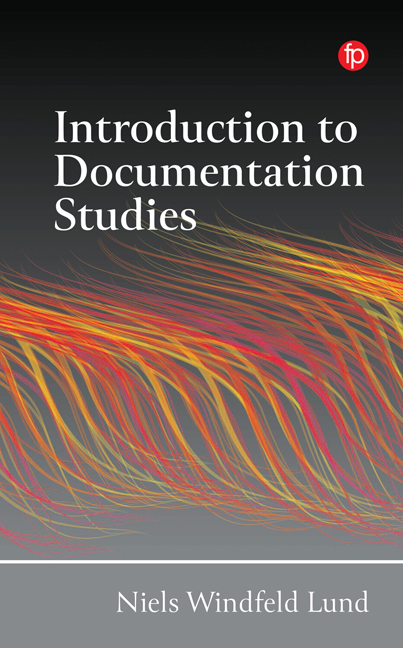 Introduction to Documentation Studies
Introduction to Documentation Studies 1 - Setting the Stage
Published online by Cambridge University Press: 28 March 2024
Summary
Introduction
If we look at the three concepts of documentation, communication, and information and compare them in terms of etymology we find the definitions as shown in Figure 1.1
From this we can get a sense of a more or less shared meaning, but also significant differences between the meanings of the three concepts.
Documentation
An oral educational tradition
If we go back to Antiquity, the word document and its Latin predecessor documentum could mean: ‘example, model, lecture, teaching, and demonstration’ (Lund, 2009, 399). An oral lecture was a document by itself and the person who delivered the oral lecture was a docent or a doctor. It could be supported by a three-dimensional document such as a model showing how things work. It was also a very gestural tradition, with the demonstration as a document by which the docent showed how one could make something with one’s hands and arms, in other words gestural acts as documents. In a similar way, one could view works by artists and craftsmen as documents. This educational tradition for document and documentation is not predominant today, but it is still alive in the notions of docent, a teacher, instructor or guide, a doctor and, last but not least, in the everyday practical learning from an example as a document on how to act and do things. Things still work like this in a large part of the world today, but in the modern Western world the predominant understanding of the notion of documentation is the written statement providing proof of something, as something true, as evidence.
A written tradition
Through history, as societies grew larger and governing powers tried to control them by impersonal means, the oral basis of law and order was gradually replaced by written contracts, and the very inscriptions became increasingly important and regarded as the basis for authority in society. Contracts, law books, and fiscal accounts became both the basis for claiming power and symbolic of it.
The same development can be seen in the religious and clerical world, with the holy books providing the basis for religious beliefs. In education too, the textbook became the symbol of knowledge. In early science, one sees a development from the oral and gestural knowledge of wise men and women to the first de-scriptions of knowledge. The book became the document itself, from which one could extract the text.
- Type
- Chapter
- Information
- Introduction to Documentation StudiesComplementary Studies of Documentation, Communication and Information, pp. 3 - 18Publisher: FacetPrint publication year: 2024
